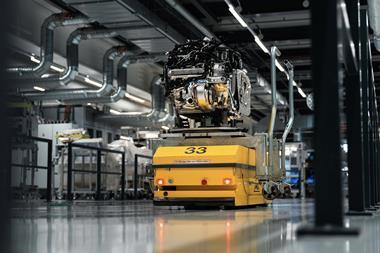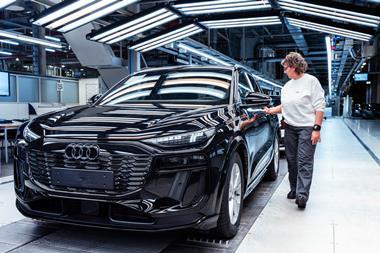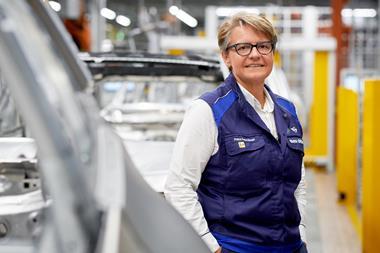Mercedes-Benz’s largest truck plant is piloting new production technologies and transitioning into the lead manufacturing facility for heavy commercial vehicles
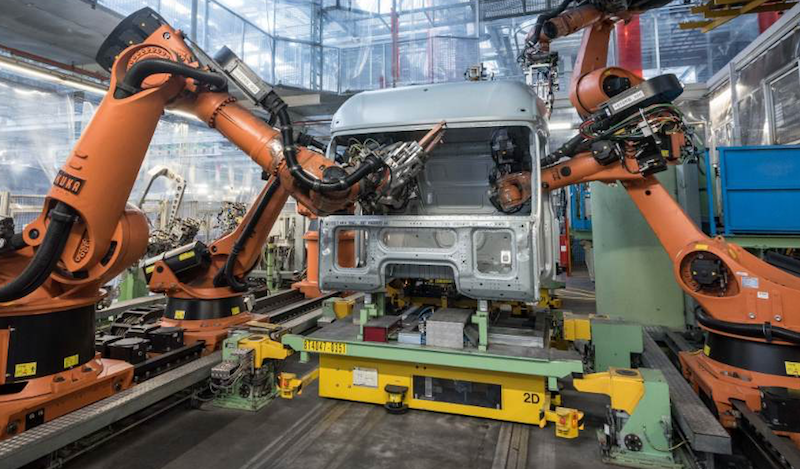 Gerald Jank, head of Wörth plant and production at Mercedes-Benz Trucks, has much to say about the challenges of producing a huge variety of models in series production while also developing new manufacturing systems and processes within the plant.
Gerald Jank, head of Wörth plant and production at Mercedes-Benz Trucks, has much to say about the challenges of producing a huge variety of models in series production while also developing new manufacturing systems and processes within the plant.
“First [comes] the need for flexibility,” he begins. “Truck markets are very volatile, where as our core markets for passenger cars might fluctuate by 5-10%, our core truck markets can move up or down by 15-20%, so you really need to be flexible in production. Here [at Wörth] we can adjust our production output to range between 60 to 120,000 units per year. To do this we use three different stages in our production operation.

“Firstly we use flexible time accounts for the workers, where during busy times they are paid for part of the time worked then ‘bank’ the rest of the time in an account for when demand falls.
“We also have very flexible cycle times so we can lengthen or shorten takt times as necessary to balance output to meet demand. “We can also bring in outside contractors if needed when demand is very high.”
“Our production network is also very flexible so we can shift production between plants to meet demand in certain markets. This optimises the use of production capacity.”
Jank also highlights that there is very much a tailor-made approach to building trucks even in the main series production models: “We offer a lot of options across the seven main models we produce,” he states. “For example, we offer 400 different colour options, 18 different wheelbases and 200 fuel combinations. So we’re trying to offer every customer the best solution for his business, with a top quality product. Quality is a key value across our plant and something we do not compromise on. Quality means reliability for our vehicles.”
A strong supply chain is also vital, notes Jank: “To offer this variety of options you require a large number of parts and very strong supplier network and supply chain management. We have combined quality management, supplier development and logistics into one function that manages the whole supply chain. We use approximately 1,000 suppliers from Germany and abroad. The average distance of the suppliers from the plant is 350km and to give you some idea of the logistics operation we have over 500 trucks delivering parts here per day.
“Our supply strategy covers both just-in-sequence and just-in-time and we are receiving direct deliveries [to the line] from sister plants and suppliers. There is also a supplier park on-site. Internal logistics are also very important as there are more than 1,000 locations in the plant where parts have to be delivered.”
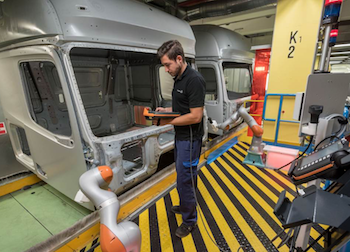 The team at Wörth are currently trialling the use of two advanced, service type robots
The team at Wörth are currently trialling the use of two advanced, service type robotsJank also emphasises the importance of developing and following a core philosophy within the plant. “We are rolling out our Truck Operating System (TOS) and our goal is to have simple and stable processes in operation throughout the plant,” he reveals. “This means understanding the flow of operations and having very transparent processes in place. We have a ‘toolbox’ of methods and systems – just-in-time, standardisation, continuous improvement, etc. – but there is also a philosophy which applies to all levels of the organisation. To achieve this we have to demonstrate this philosophy, with senior management being role models, also through our training and shopfloor management. Here, section managers and line workers look at simple KPIs, establish if there are any issues and how these should be addressed. This provides a shared understanding about what is happening in the plant and where any improvements can be made.”
Automation is a major part of the drive for efficiency and quality in production. “To be able to handle the complexity of production but also maintain high levels of quality, technology is very important,” Jank concurs. “We have a highly automated bodyshop where we use robot welding cells, AGVs to transport the cabs between sections and an automated quality check system. We also have just started new project using smaller collaborative robots to improve working conditions.”
Asked about the biggest challenges faced by production operations, Jank replies: “There are a number of different challenges that are interconnected. We are in a transition phase at this plant; Wörth will still be the biggest truck plant in the Mercedes-Benz network but volumes will not increase. This plant will become the centre of competence for the entire production network. This means if a new product is launched, the related production processes will be developed here. Once they are fully tested and developed they can then be transferred to other plants in the network. Many of the things we have discussed that are being developed here will be used in other plants.
“We also have a huge CKD operation and we have a lot of competence and experience. We are developing our CKD processes here and also helping other plants to produce the trucks on a CKD basis.”
“Increasing the crossover of components is important and Wörth will play the key role in developing this. So bringing all these elements together, to function as a production plant and a development centre, leading the production network is a big challenge.”
Service robot projectAs the plant has no press shop, all cut and formed panels are supplied to the bodyshop at Wörth from other Daimler plants or outside suppliers. In the door assembly area, the hinges and doors are attached to the BIW cabs prior to paint. This might seem like a relatively simple task but it’s deemed a safety-critical one, and as such the fitting and fixing of the doors and hinges goes through a four-stage process. Until recently this has been an all-manual operation, but the process was seen to be inefficient so the final torque tightening stage has been automated.
The team at Wörth are currently trialling the use of two smaller, service type robots, supplied by Kuka, to perform the final tightening procedure. These are very advanced, seven-axis, lightweight units, featuring internal sensors and cabling, which occupy very little space at the line-side. The cabs, with doors and hinges attached, are moved down the line with the front of the cab at 90° to the direction of travel. This presents the hinge mounting points to the two robots, which then touch a number of reference points on the cab body to calibrate and orientate positioning of the torx screwdriver. They then proceed to tighten each bolt in a specific sequence. All of this operation can be monitored automatically and the data stored for future reference.
The motion of each robot when locating the screwdriver into the head of the bolt is almost human in its dexterity and movement to adjust its position. They are designed to operate in close proximity to human workers and sensors detect any unexpected contact, causing the robot to pause until the work area is clear and it is safe to proceed. These sophisticated robots are surprisingly easy to program. They can be placed into a learning mode which allows a human worker to move the robot arm manually through a series of movements need to perform the task. The robot will then ‘remember’ these movements and reproduce them exactly. Gerald Jank notes that these smaller robots are in fact easier to program than the larger industrial types used elsewhere in the bodyshop.
Asked about any other applications for this type of collaborative automation, director of production, Dr. Ingo Ettischer says that they are looking at the underbody sealing operation in the paintshop as this can be ergonomically challenging for human workers.
Automation a key elementThe application of automation is a key element in enabling Mercedes-Benz to offer its customers the huge number of vehicle variants needed to meet market demand. The bodyshop producing the cab BIWs is fully automated with more than 250 Kuka robot welding cells that can produce 550 cab variants. Each welding robot is programmed to perform up to 230 different weld operations with the cabs moved between cells by 130 AGVs. Each cab is mounted on an adaptable carrier that can accommodate any variant produced. With this number of variants being built all of the equipment is designed to be flexible.
"Our production network is also very flexible so we can shift production between plants to meet demand in certain markets. This optimises the use of production capacity." - Gerald Jank, Mercedes-Benz Trucks
All the completed BIW cabs pass through an inline automated quality check. The cabs are lifted by two robots onto an adjacent line where robots fitted with vision systems check and measure 100 points on the cab body; the task being completed in 120 seconds. The results are monitored by a team from an adjacent quality control room. Any cabs that are outside the very tight tolerances are removed from the line and subject to further investigation and detailed measurement using both CMM and a Zeiss ‘Eagle Eye’ contactless system to identify the problem area. The bodyshop manager is also responsible the quality control area so as to provide continuity.
Reducing the paper trailIndustry 4.0 is a big theme in the development of processes across all sections of the plant. This is about efficiently managing huge amounts of data and going to a paperless system will be a part of that. For example, at the cab assembly line, currently 50,000 paper checklists are produced daily across all the processes in production, which then need to be scanned in order to be saved as digital files. Although paper lists are still widely used in vehicle manufacturing operations, mainly because they are a relatively simple and easily transferable process, they do create additional problems – not least in adding 46 minutes to the assembly time of each truck simply through the need for the operative to move, check, sign-off, collate and save the paperwork.
At Wörth, they are working on a project whereby the assembly line workers use tablets and small mobile devices to check and sign-off the operations, removing the need to print sign-off materials and walk away from the cab. All data regarding the vehicle, operation, worker, etc. is then automatically saved and stored for future reference. The only remaining paper element is the vehicle spec sheet, which accompanies the vehicle through each section of assembly.
 Assembly line workers use tablets and small mobile devices to check and sign-off the operations
Assembly line workers use tablets and small mobile devices to check and sign-off the operationsSpeeding up production schedulingThis project is part of a plant-wide programme to radically improve the efficiency of data management. At the Wörth plant the complexity of production scheduling is exacerbated by the huge number of variants produced, with the current IT system taking up to six hours to process just one day’s production scheduling. Jank explains that a new IT system is being developed that will cut this time to just one hour, the aim being to bring the new system on line in early 2017.
Another area of note is at the plant is in line-side logistics, creating the parts kits for the assembly operations. Jank comments on what he calls ‘waste management’ – not the by-products of manufacturing but the reduction of non-value-added operations. A simple example of this has been the use of kitting and improved parts presentation to dramatically reduce the amount of walking and parts handling required by the assembly operatives. As a result, the non-value-added work has been reduced by 15%.
The kits and presentation of parts have been developed with a great deal of input by the assembly teams, but this expanded requirement for kits has placed additional pressure on the in-plant logistics teams. Here too, a great deal of development has gone into the picking operations and delivery of parts. The logistics teams use a ‘pick-by-light’ system to ensure the correct, sequenced parts are collected. The parts aisles have been redesigned to allow easier reach for components and an efficient flow to the picking operation. This sees the full carts delivered to the waiting AGVs for transport to the line-side.
Jank explains that apart from all the already implemented projects, they are still discovering what can be achieved through Industry 4.0, and this means the core philosophy mentioned earlier is being continuously adapted and developed to keep pace. He also notes that although the scale of the projects seem large, they were part of a very structured strategy, with a very methodical approach seeing each project through to fruition before commencing the next.
























